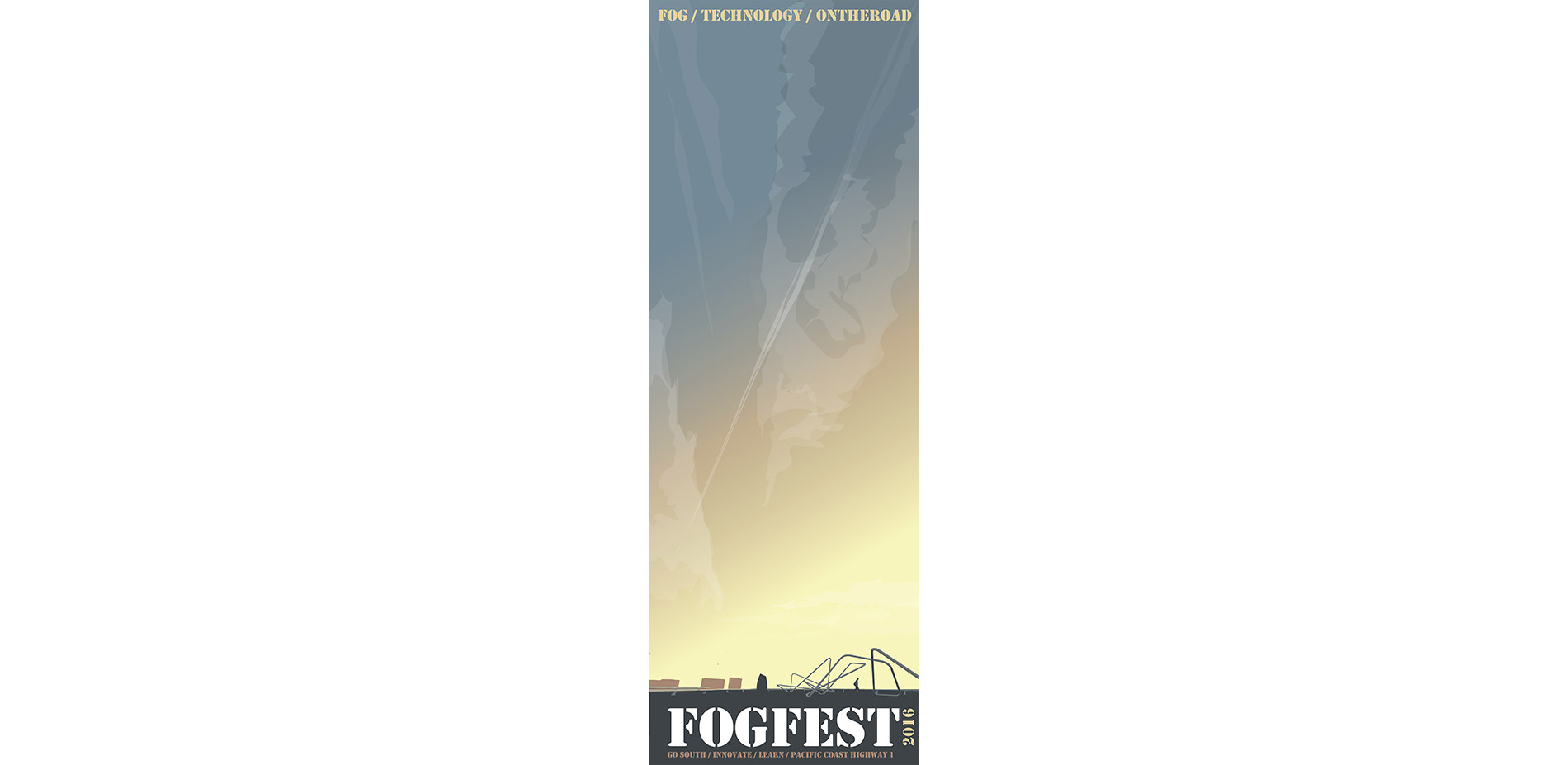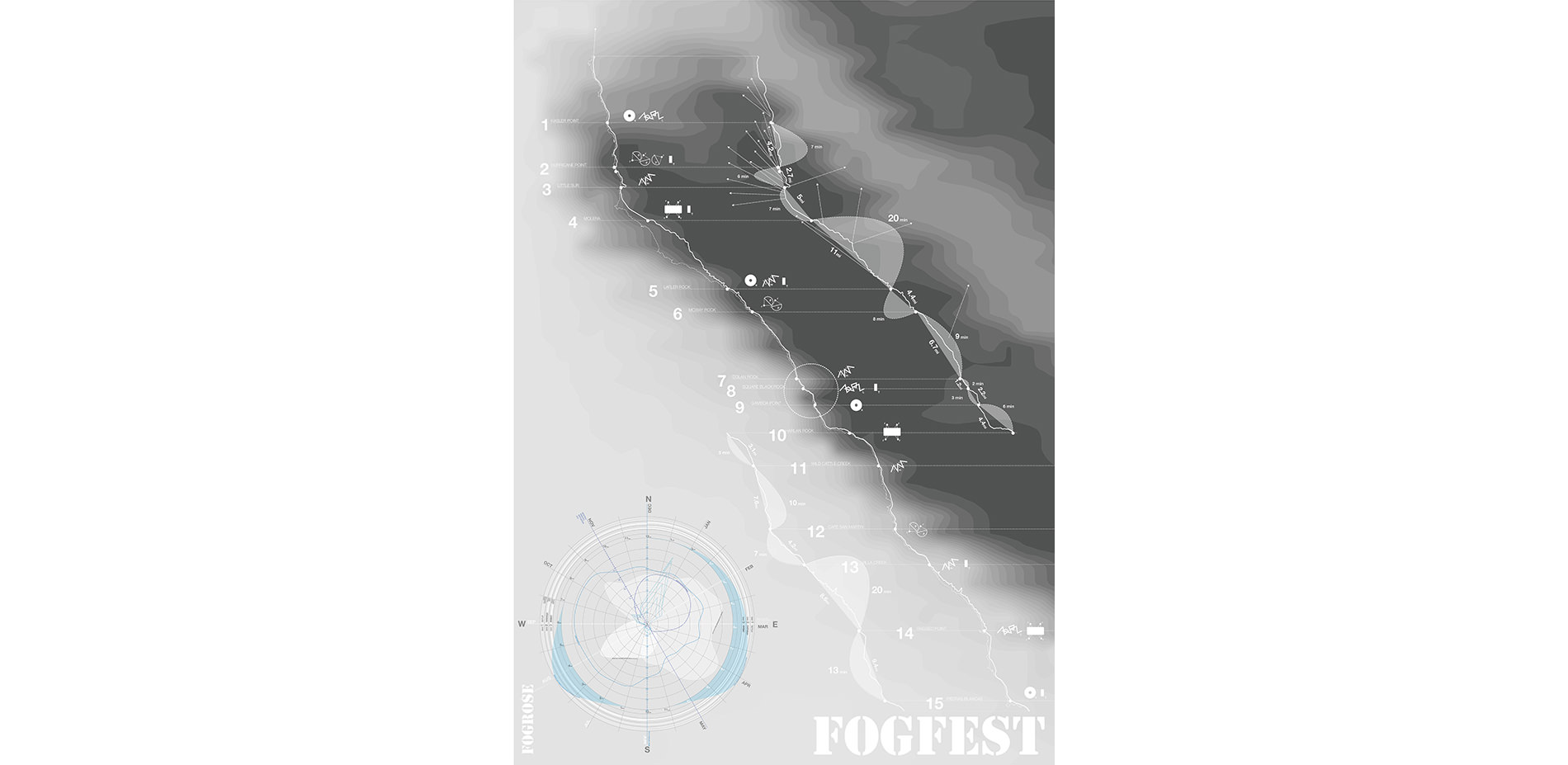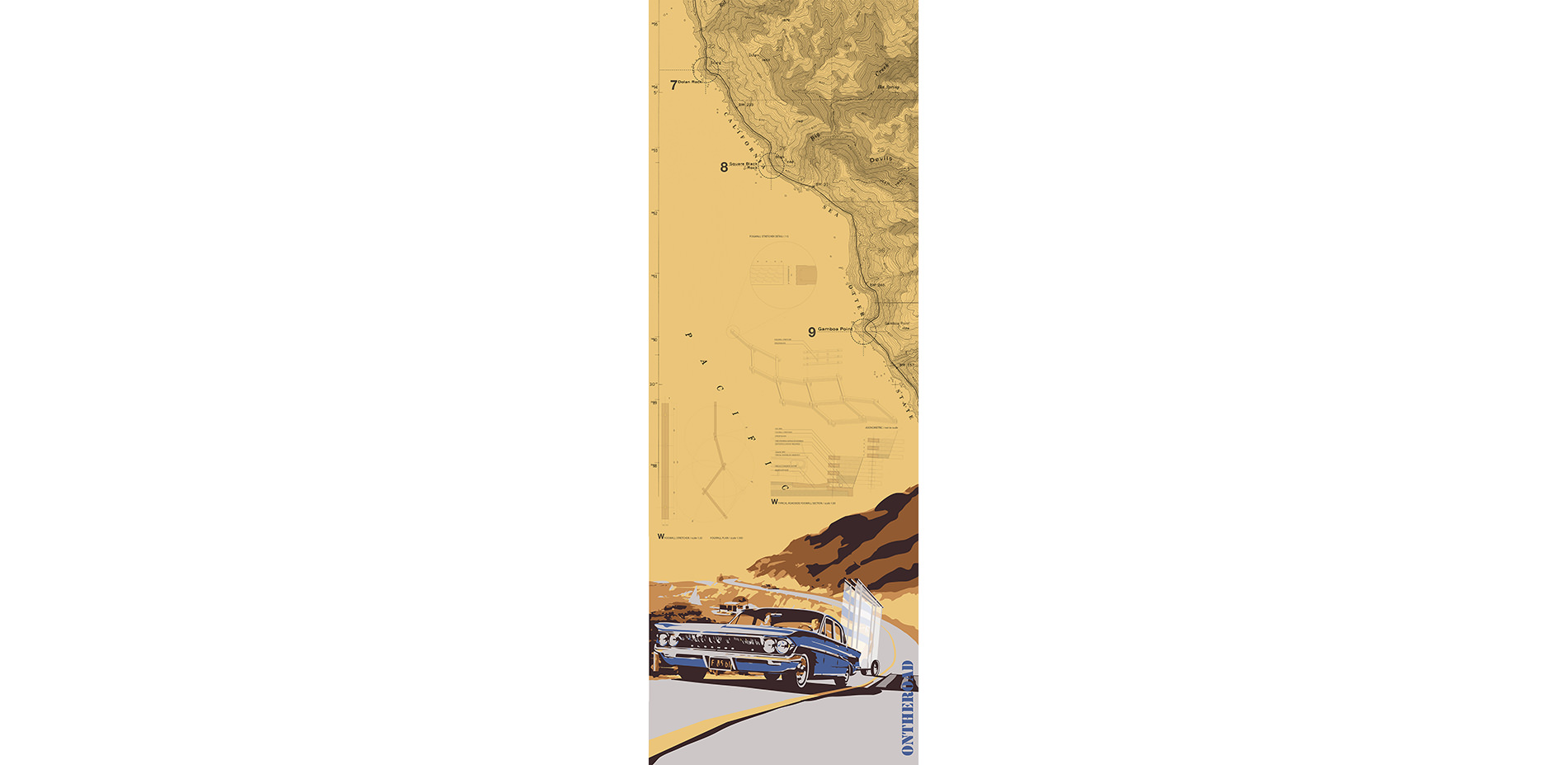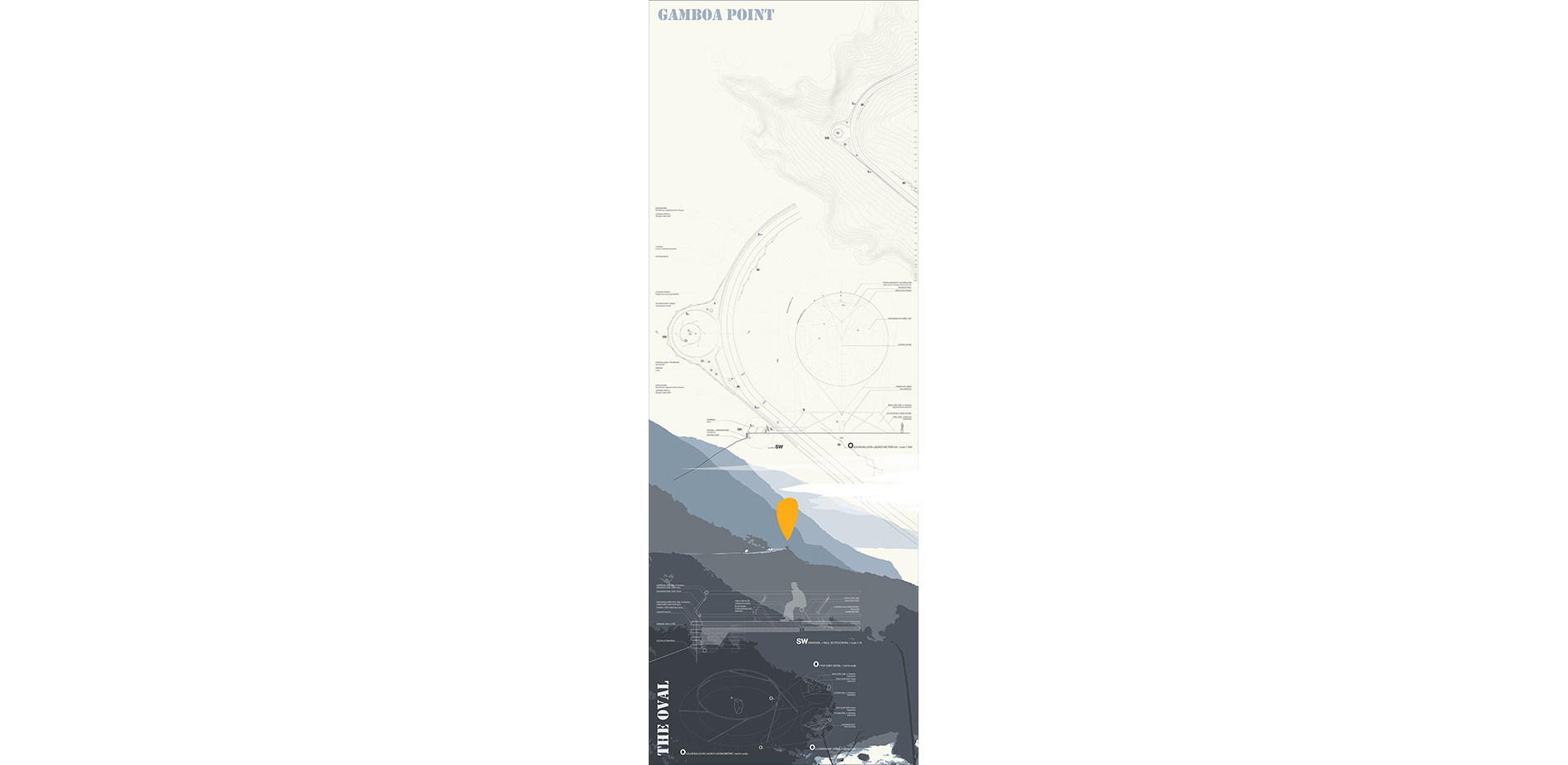PROJECT NARRATIVE
The Festival is an excuse to restore Highway 1 as an important piece of California's landscape infrastructure. My mission as a landscape architect was to prepare specific sites for the festival to take place, and also to design a series of infrastructures that can be used during the festival (temporary) but also after the festival is over (permanent).
The festival's motto is FOG / TECHNOLOGY / ON THE ROAD. These three components act as guidelines for what the festival is about, but also provide the three ways in which the festival should be understood:
-
FOG: Fogfest is obviously a festival about collecting water from the clouds, however collecting fogwater is anything but obvious. This needs careful schedulling, because fog is not always present on Highway 1 throughout the year, and also there is a specific time during the day where the chances of collecting fog water are higher. This is why I developed a 'Fogrose,' which as a more complex relative of the windrose, combines data of fog presence during a normal year, with fog collection data in an average day. The best time for the festival is from June to September and the fog shows up usually at night and early morning. The Fogrose not only mandates the time for the festival, but also the Festival's schedule of activities. Fogfest must happen on a weekend during August, with the fog collection starting at 12am and ending at 10am, during the first and second nights. During the day, the participants’ setup their devices and also teach / learn from the other participants. The third day is a party and then wrap up. Fogfest is not only an opportunity to create environmental awareness and learn about our interactions with the atmosphere, but also an opportunity to improve fog collection technology and have fun.
-
TECHNOLOGY: The technological component of Fogfest starts from the creation of a series of devices that evolve from the idea of the deck chair as an artifact that can create pop-up space. After a series of modifications, the adaptability of 'pair of scissors' type structures is taken further to develop retaining walls that can adapt to different road geometries, and also a fog collection device called "The Fogmobile." This artifact would have a protagonic role during the festival, being able to be deployed on site to collect fogwater, and then folded, attached to a car, and pulled as a trailer to a different site.
On the other hand, there's a series of structures that develop on the idea of 'the line' as an element that can create space by bending, but that can also provide structure for the festival's participants to attach their devices (balloons, inflatables, fabrics, mesh, etc). The Snake rail creates a simple roadbarrier with 3 different adaptations to create a linear bench, a double roadbarrier, and a simple handrail. On the same line, are the Light Sculpture and the Oval, two elements that are pecifically designed to become anchor structures for inflatable / planar mesh devices. These linear elements after the festival is over, will continue to provide spatial structure and character to the outlook points of Highway 1.
As the festival takes place mostly over night and early morning, light will become a crucial element to work with. The Light Chamber (toilettes) and the Light Sculpture will act as lighthouses, creating reference points that will provide the participants with the sense of distance and the amount of fog coverage during the night.
All of the other elements like balloons, inflatables, parachutes, fabric fogcollectors, etc, should be brought to the Festival by the participants. These open source piece of the Festival is what will provide dynamism to the landscape, transforming Highway 1 into a landscape of the unexpected, a space open for new relations between human beings and the air.
-
ON THE ROAD: 15 sites were selected along the road for Fogfest. Each one of these sites will be configured with a combination of permanent and temporary Fogfest 'technologies' to provide each one with a certain character and amenities. The selection of these sites was done by first the probability of cloud coverage (overlaid in the Fogfest main map are the Isolines of 10 years of data gathering of Fog coverage along Big Sur coast), and also a pacing and separation depending on time. Highway one is a road where you drive slow, so the relationship between time and distance is altered. Not always how far you see means that you'll reach that place fast. This is why the division of programming was done every certain time lapses over distances. Toilettes for example are set every 20 minute drives, Ovals (to attach balloons) every 45 minutes, and Light sculptures every one hour. When you set events on the road, the important thing to remember is when you forget.
After the first overall site selection, I focused on 3 specific vista points at the central portion of the road. These sites act as a demonstration of the variability of Fogfest technologies as a system. Each one of the sites has a simple basic configuration of an asphalt carpet to withstand the heavy car use present in Highway 1 throughout the year, and also a "Drainage Edge / Promenade" of black gravel to manage runoff and reduce slope erosion on the cliffs. Underground water tanks would collect the water captured from the clouds. Each one of the sites highlights a specific 'Fogfest Technology', as follows:
-
Dolan Rock. The Fogmobile: This long site provides two main areas for deploying fog technologies on the extreme sides, configured by bending Snakerail road barriers. At the center, plenty of parking space is provided, and at the edge, the drainage promenade creates space for a long walk along the cliff to contemplate bith the horizon and the Fogmobiles. The fogmobiles would be deployed on the two main asphalt areas to collect water during the festival.
-
Square Black Rock. The Light Sculpture and the Light Chamber. This site is configured by the snake rail to create a main area for the light sculpture on the north side, and also 4 light chamber (toilettes) alog the edge. Each one of these frosted glass wall toilettes is pointed directly to each one of the largest rocks right next to the cliff. The site would become a major reference point during the nights of the festival.
-
Gamboa Point. The Oval. If Square Black Rock and the Light Structured vista points are the main highlights at night, the Oval Outlooks will become the main reference points during daytime. The Oval is configured to create an anchor point for large balloons who act as picturesque 'eyecatchers', turning these places into important follies along the road.
The last component of the Fogfest Technologies is maybe one of the oldest testimonies of human technological evolution: Rocks. Several rocks will be placed in each of these sites, not only as a reminder of the California Coast geology, but also as a statement of the evolution of our techniques to modify the land. Any of Fogfest's high tech temporary devices could use a rock (a menhir) as an anchor point. It is right in this opposition, these threshold between the ancient and the technological, between the geology and the atmosphere where Fogfest wants to take place. Our planet and our future evolution as a species need to start inhabiting these threshold landscapes. Future is in the air.

















